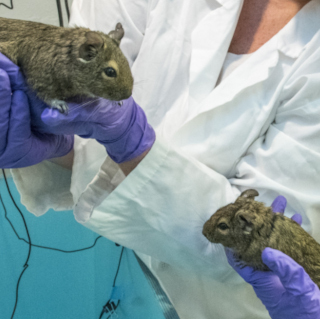Rat Husbandry and Care
Last Review Date: January 6, 2021
I. Purpose
This Standard Operating Procedure (SOP) outlines the animal care requirements associated with the daily husbandry of rats to ensure consistent and uniform care. This procedure applies to all personnel involved in the care of rats housed in static micro-isolator caging in the Laboratory Animal Resources (LAR) facility on the campus of the University of Montana.
II. Policy
It is a LAR policy to meet or exceed all federal, state, and local regulations and guidelines and to comply with all institutional policies and procedures as they apply to the use of animals in research. LAR personnel must pass on-line animal training modules and attend applicable training in animal care and use, occupational health and safety, and equipment operation prior to performing activities outlined in this SOP. Animal housing rooms should be entered using appropriate personal protective gear for the species and disease or hazard containment level.
III. Husbandry
Daily routine
- Record the room’s high and low temperature and humidity readings.
- Observe animals for any signs of disease, illness, or injury.
- Report any animal illness to Attending Vet and the PI
- Top off water bottles (if ½ full or less) daily.
- check that lixits are free of debris before replacing water bottles
- Check food levels in hoppers. Top off any food that seems low
- Sweep and mop the floor with Peroxigard concentrate (Mon/Wed/Fri) or water mop (Tues/Thurs)
- Empty trash
- Replenish and sanitize food and bedding bins as needed
- Check the expiration dates of feed
- Fill out checklist sheet, census sheet, and initial daily log
Weekend routine
- Record the room’s high and low temperature and humidity readings
- Observe the animals for signs of disease, illness, or injuries
- Report any animal illness to the Attending Vet and the P.I.
- Check to make sure there is an appropriate amount of food in the hopper
- Check to make sure there is plenty of water in the water bottle
- Fill if less than ½ full
- Fill out the checklist sheet, census sheet, and initial the daily log.
Weekly routine
- Bedding change – Monday and Thursday
- Using the transfer station, move the box with the rats from the rack to the hood,
- transfer rats to clean box with clean autoclaved bedding and new nesting sheets
- Replace any enrichment items as needed.
- Refill food and water.
- Replace the rats in the new caging back on the rack
- Wipe down the racks with Peroxigard as you move the dirty cages to the change hood.
- Make sure the dirty boxes are covered and transport to the dirty cage washroom to be processed.
- Complete cage wash – Alternate Thursday from Bedding change.
- Using the transfer station, move the box with the rats from the rack to the hood.
- Transfer rats to the new box, with clean, autoclaved bedding, and new nesting sheets.
- Replace enrichment items as needed.
- Replace cage card, hopper, lid, and water bottle with new items.
- You can transfer the remaining old food into the new hopper. If the food is still viable. Top off with new food.
- Wipe down the racks with Peroxigard as you move the dirty cages to the change hood.
- Wipe down transfer hood with Peroxigard.
- Lift the top of the transfer hood off
- Clean any debris that may have fallen under during the change
- Spray and wipe down with Peroxigard
- Replace the top of the transfer hood
- Make sure the dirty boxes are covered and transport to the dirty cage washroom to be processed
Monthly routine
- ASC (see ASC SOP)
- Sanitize food and bedding barrels
- Clean and disinfect barrels once a month, after removing contents
- Keep the feed and bedding information cards up to date
Wet Box
- Replace wet box and related items with new clean items
- Using the transfer station, transfer rats from the wet box to the new clean dry box
- Make a note on the cage card and on the daily log sheet of wet box change and any concerns
